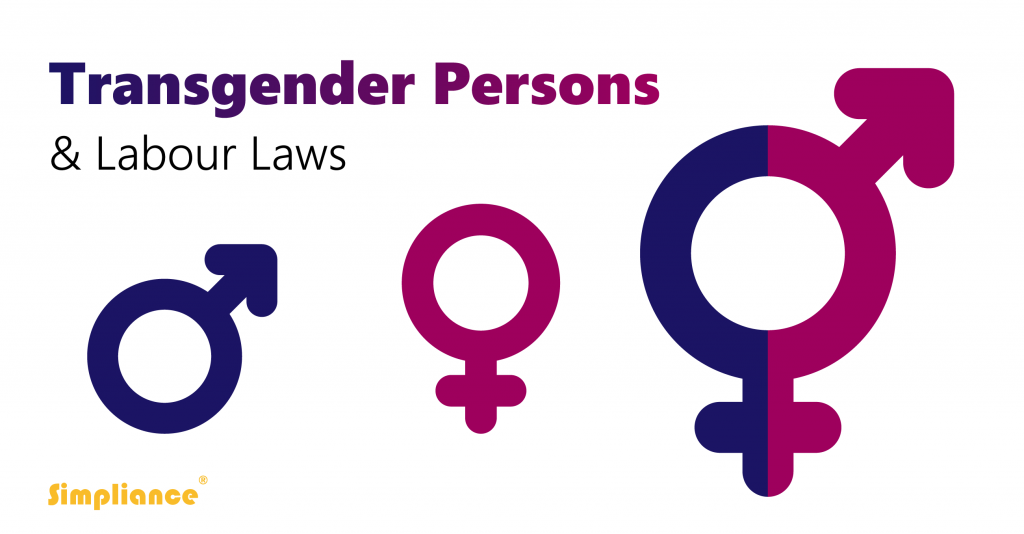
Introduction
Laws in India had been strictly binary in terms of their recognition of gender for a long time, recognizing only men and women. In this sense the lack of recognition could be termed a non liquet or a lacuna in the law. However, the change in global outlook towards transgender persons has resulted in a corresponding shift in India as well. The Supreme Court’s judgement in the case of National Legal Services Authority v. Union of India was the first major illustration of this shift, as the Court declared transgender persons apart from binary genders and affirmed their identities as the third gender under our Constitution. This was followed by the Transgender Persons (Protection of Rights) Act, 2019 that established the National Council for Transgender Persons and imposed penalties for offences committed against transgender persons.
The above is a general overview of laws relating to transgenders in India, however, in the context of labour laws the law still remains very much binary for gender recognition.
On an international level, the Discrimination (Employment and Occupation) Convention, 1958 imposes an obligation on ratifying States to declare and pursue a national policy that aims to promote equality of opportunity and treatment in respect of employment and occupation. This includes enacting legislation, carrying out educational programmes, repealing any legislation repugnant to the above-mentioned policy and ensuring observance of the same under the control of a national authority. India has ratified this international convention and as seen in the first paragraph, is moving in the right direction on a general level. However, there are still a lot of grey areas that need to be addressed to provide transgender persons with rights and benefits commensurate with those provided to cisgender workers.
This article shall examine the gaps in the law that need to be filled, the need for further regulations and steps that can be taken by employers to diversify their workforce and make their workplace transgender friendly. However, before the above analysis becomes the focus of this article, the author shall briefly examine the provisions of the Transgender Persons (Protection of Rights) Act, 2019 to determine whether it provides for any labour/employment related matters.
Transgender Persons (Protection of Rights) Act, 2019
The 2019 Act defines transgender persons and prohibits denial of and termination from employment or occupation as a means of discrimination under Section-3(c). The contentious provisions under Section-5 of the Act provide the procedure for a transgender person to obtain a certificate of identity. Section-9 of the Act clearly provides that no establishment shall discriminate against any transgender person in any matter relating to employment including but not limited to, recruitment, promotion, and other related issues.
To this end Section-10 imposes an obligation on establishments to ensure compliance with the provisions of the Act and provide the facilities that are prescribed. Section-11 requires every establishment to designate a person to act as a complaint officer to deal with any grievances related to violations of provisions under the Act.
From the above it is clear that there is some, although not expansive, regulation covering transgenders in workplaces. We shall now examine the gaps in existing legislation that need to be addressed to shed some light on the practical difficulties that arise due to the grey areas in the law.
Practical Difficulties & Possible Solutions[s21]
Some of the difficulties that have arisen as a part of employers’ concerted effort to diversify their workforce can be understood only in the context of labour law compliance. The illustrations being offered herein are real problems that have been faced by our clients and thus expose a lack of clarity in the law. One such instance arose during the filing of Form ‘D’ under the Equal Renumeration Act, 1976 and its corresponding rules. It essentially requires employers to maintain a register of workers with details pertaining to their renumeration and their personal information which includes gender. A great deal of confusion ensued because Form ‘D’ only provides for columns pertaining to number of men employed and number of women employed. Thus, employers were unsure as to where they can categorize their transgender workers as Form ‘D’ did not make any provision for the same.
A similar situation arose under the Maternity Benefit Act, 1961 as there was confusion over whether transgender employees are entitled to maternity benefits. This is because the Act uses the word ‘woman’ throughout and defines it under Section-3(o) as a woman employed, whether directly or through any agency, for wages in any establishment. Transgender men, basically those persons who were assigned the female gender at birth are capable of giving birth under some circumstances. Thus, this resulted in confusion from a compliance perspective as the employer in this situation was unsure as to provision of benefits as well as procedural norms such as the various Forms under the Act that only refer to women.
The solution to the first problem is fairly straightforward, Form-‘D’ can be modified by adding a column for transgender workers so that their details are accurately represented. The solution to the second problem is slightly more complex as it involves a determination of whether the transgender individual in question is capable of giving birth. However, most State rules under the Maternity Benefit Act, 1961 require submission of a Form that is signed by a medical practitioner affirming the existence of a pregnancy. Therefore, the existing system has the requisite mechanism to ensure transgender pregnancies can be accounted for[s22] .
Another major problem several employers face is that of a lack of gender-neutral washrooms and locker facilities/changing rooms. Often resulting in humiliation for transgender persons as they are forced to use male washrooms. This can be easily resolved by providing gender neutral washrooms in addition to male and female washrooms in workplaces. Similar steps can be taken with regards to changing rooms and locker facilities to ensure that transgender employees are comfortable.
Internal Measures to Make Your Workplace Trans-friendly
While the discussion above related to changes in regulations that can be introduced or modified, this section of the article examines internal policy measures that may be implemented to make a workplace more inclusive. These are as follows:-
Inclusion of sensitization and awareness programmes as part of company policy to educate their workforce on gender inclusiveness and acceptance of transgenders in the workplace. This would entail dismissing any misnomers about the validity of trans-identity, respect for their preferred pronouns and appropriate behavior in the workplace.
Regular update of policies and its periodic review to ensure HR, administrative, operations and recruitment activities are carried out to promote inclusiveness and diversity. For the same to be beneficial, it is important that a transgender person is a part of the Committee responsible for carrying out this function. Some notable examples of this measure include modifying sexual harassment policies to include complaints made by transgender persons and ensuring that grievance redressal mechanisms include a transgender individual.
Other measures include updating personnel records to ensure transgender persons are not incorrectly classified as men or women as the case may be. Changing dress code norms to make them gender-neutral thereby avoiding gender stereotypes and applying the same consistently. These can form a part of trans-specific policies that not only recognize the distinct identity of such persons but also provide for their needs in accordance with that recognition.
Conclusion
The above procedural difficulties and grey area led the author to examine the new labour Codes to determine whether they provide for any significant changes regarding transgender persons. The Code on Wages, 2019 read with its draft Central Rules and forms reveals that Form-I (Register of Attendance, Wages, Overtime, Fine, Deduction for Damage and Loss) and Form-IV (Format of Employee Register) use the terms sex and gender respectively. This might lead to confusion similar to the instances cited in the preceding portion of the article and should be addressed by the Ministry before the Rules are released in their final form. A separate column for transgender workers would eliminate the confusion entirely and make their inclusion smoother from a labour law compliance perspective.
The Code on Occupational Safety, Health and Working Conditions, 2020 imposes a responsibility on employers to ensure transgender persons have separate washroom facilities, bathing places, locker-rooms, and shelters. The Code on Social Security, 2020 and the Industrial Relations Code, 2020 do not deal with transgenders specifically under any of their provisions.
Thus, we see that in spite of the incremental changes that have come about as a result of international awareness and progressive decision-making by the Supreme Court, the recognition of transgender persons under labour legislation is still in its nascent stages. The Ministry of Labour and Employment must ensure that there is a concerted effort to include transgender persons at all stages of the law-making process and provision for their distinct requirements under the Codes as well as the supplementary rules.
Do you think our labour laws provide for transgender persons adequately? What according to you, are the reforms that can promote inclusivity and diversity at the workplace? Have you faced any practical difficulties with compliance due to grey areas pertaining to transgenders?
Drop your thoughts and queries in the comments below.
| Disclaimer: This blog is meant for informational purposes and discussion only. It contains only general information about legal matters. The information provided is not legal advice and should not be acted upon without seeking proper legal advice from a practicing attorney. Simpliance makes no representations or warranties in relation to the information on this article. |



Can an employer in INDIA make it mandatory for employees to update their gender in the HR tool.
Greetings,
Thank you for writing to Simpliance.
As general practise, company should ideally give employee a disclosure as to why it requires them to identify their gender in the company’s HR portal. This should also include the fact that such disclosure shall be protected by the relevant data privacy laws. Also, the company cannot mandate such disclosure and should give the employee the choice to disclose such information. There is no law in India that requires the employer to obtain such disclosure from an employee. Once the employee opts to disclose their gender, the company should ensure that the choices are not limited to Male and Female but also include an “others” option where the employee could identify their respective gender.